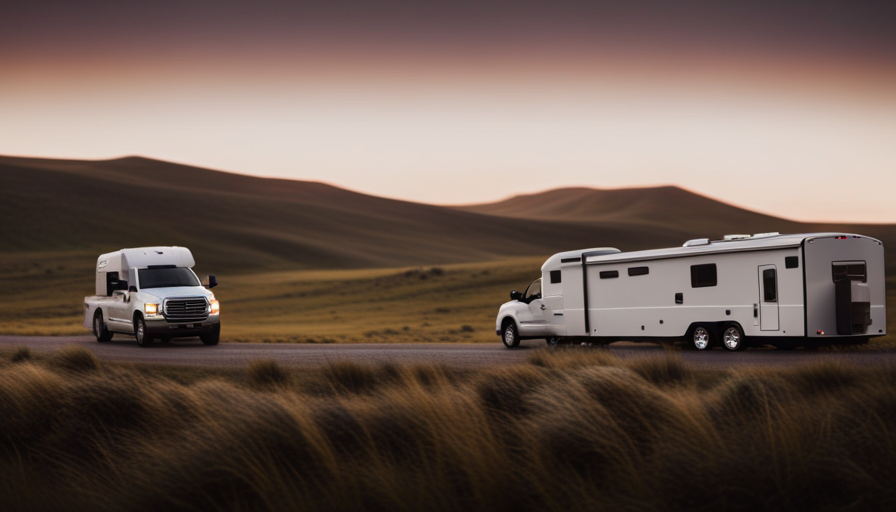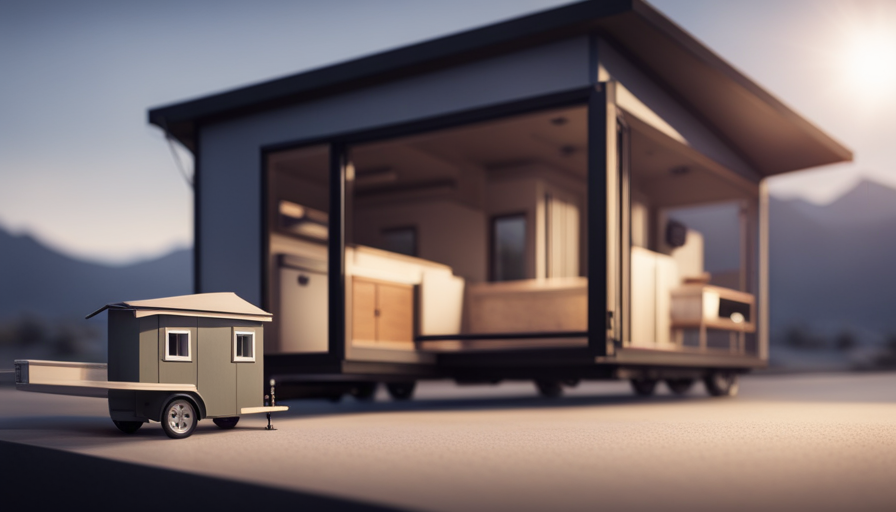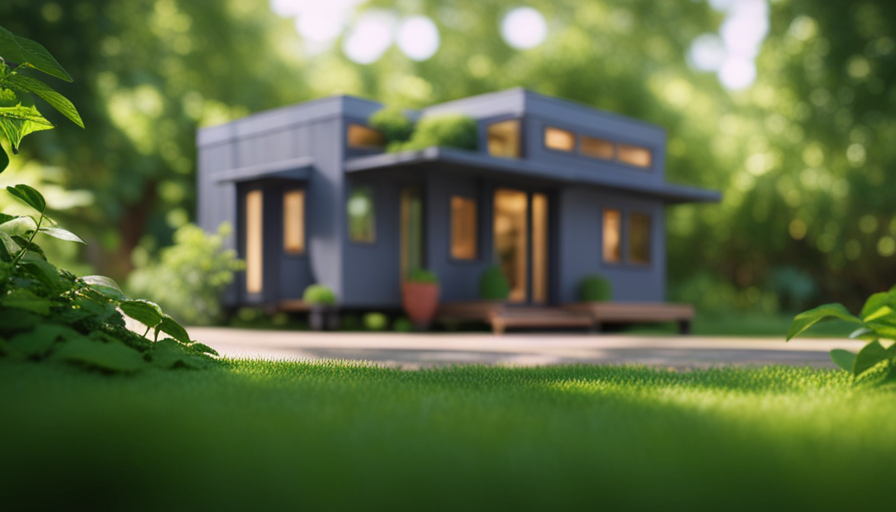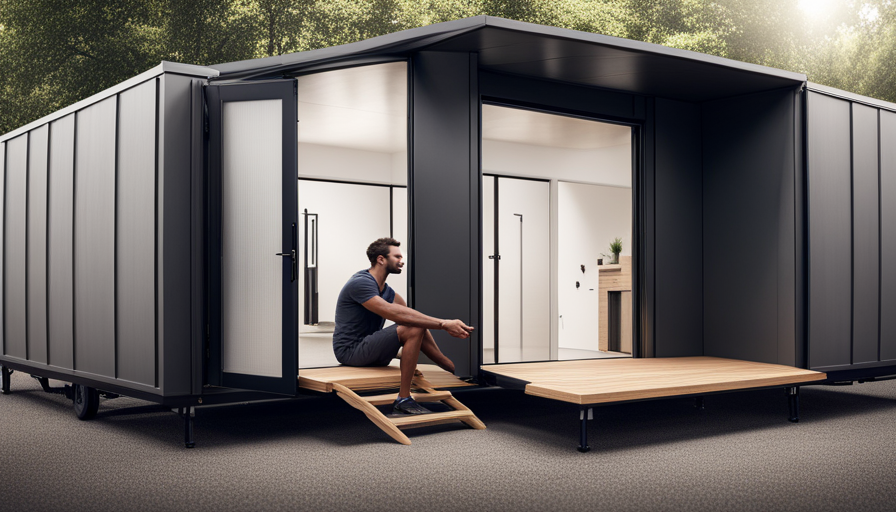What size tiny house can my Tundra tow? This is a frequently asked question for individuals interested in the freedom of living in a tiny home. To determine the answer, it is necessary to examine the towing capacity and weight limits of the Tundra.
In this informative article, I will guide you through the process of determining the maximum size of a tiny house your Tundra can safely tow.
First and foremost, it’s crucial to know your Tundra’s specifications. Familiarize yourself with its engine power, axle ratio, and transmission type, as these factors directly impact its towing capabilities. Then, consider the weight of the tiny house you have in mind. Remember, every pound counts when it comes to towing.
To get a clearer picture, calculate the Gross Combined Weight Rating (GCWR) of your Tundra. This rating represents the maximum weight your vehicle and trailer can safely handle. Next, determine the maximum towing capacity of your Tundra, which is the maximum weight it can tow without causing damage or compromising safety.
Don’t forget to check state and local regulations as they may have specific restrictions on towing capacities and dimensions. It’s always better to be safe than sorry. Additionally, consulting with professionals and experts in the field can provide invaluable insights and guidance tailored to your specific needs.
Lastly, test and practice your towing skills before hitting the road with your tiny house in tow. It’s essential to feel comfortable and confident maneuvering your Tundra with the added weight of a tiny house.
So, if you’re ready to embark on the journey of tiny house living, join me as we delve into the details of how big of a tiny house your Tundra can pull. Get ready to embrace the freedom and possibilities that await you.
Key Takeaways
- Familiarize yourself with Tundra’s specifications like engine power, axle ratio, and transmission type
- Calculate the Gross Combined Weight Rating (GCWR) to determine maximum weight Tundra can handle
- Consult professionals for tailored guidance and consult state and local regulations for towing capacities and dimensions
- Test and practice towing skills before hitting the road
Understanding Towing Capacity and Weight Limits
You’ll be thrilled to know that understanding towing capacity and weight limits will give you the confidence to determine just how big of a tiny house your Tundra can effortlessly pull.
When it comes to towing, it’s important to consider your vehicle’s weight capacity and the capabilities of your towing equipment. The weight capacity refers to the maximum amount of weight your Tundra can handle safely, including the weight of the trailer and its contents.
To determine the towing capacity of your Tundra, you need to refer to the owner’s manual or contact the manufacturer. They’ll provide you with the specific weight limits for your vehicle, taking into account factors such as engine size, transmission, and axle ratio. It’s crucial to adhere to these limits to ensure safe and efficient towing.
Equally important is your choice of towing equipment. Your Tundra should be equipped with a towing package that includes a hitch receiver, wiring harness, and trailer brake controller. These components are designed to enhance your vehicle’s towing capabilities and provide a secure connection between your Tundra and the tiny house.
Now that you understand the basics of towing capacity and have the appropriate towing equipment, it’s time to delve deeper into knowing your Tundra’s specifications. This will allow you to make an informed decision about the size of the tiny house your Tundra can handle with ease.
Know Your Tundra’s Specifications
With its impressive towing capacity, your Tundra can effortlessly whisk away a compact abode, turning any journey into a nomadic adventure. To determine the compatibility between your Tundra and a tiny house, it’s crucial to know your truck’s specifications.
Here are a few key details to consider:
-
Towing Capacity: Check your owner’s manual or consult with a Toyota representative to find out the maximum towing capacity of your Tundra. This will give you a clear understanding of the weight limits it can handle.
-
Gross Vehicle Weight Rating (GVWR): The GVWR is the maximum weight your Tundra can safely carry, including passengers and cargo. It’s essential to factor in the weight of the tiny house and ensure it doesn’t exceed the GVWR.
-
Trailer Tongue Weight: This is the downward force that the tiny house exerts on the hitch of your Tundra. It’s crucial to maintain a proper tongue weight to ensure stability and control while towing.
-
Towing Safety Precautions: Always adhere to the manufacturer’s guidelines for safe towing. This includes using a weight distribution hitch, checking tire pressures, and ensuring the tiny house is properly secured.
Considering the weight of the tiny house is just the first step in determining if your Tundra can pull it effortlessly.
Consider the Weight of the Tiny House
When considering the weight of a tiny house that my Tundra can pull, there are a few key points to keep in mind. First, weight distribution and tongue weight are crucial factors to consider for safe towing.
Second, dimensions and length restrictions play a significant role in determining the size of the tiny house that can be towed.
Lastly, it’s essential to consider any additional load and cargo that will be added to the tiny house, as it can affect the overall weight and towing capabilities of the Tundra.
Weight Distribution and Tongue Weight
Given the importance of weight distribution and tongue weight, it’s fascinating to explore how much of a tiny house your Tundra can effortlessly tow. Weight distribution refers to how the weight of the tiny house is distributed over the trailer, while tongue weight is the downward force exerted on the hitch ball by the tiny house. Both factors play a crucial role in ensuring safe and stable towing.
The Tundra’s towing capacity is determined by its engine power, suspension, and braking system. It’s essential to check your Tundra’s owner’s manual or consult with a professional to determine its specific towing capacity. Once you know this, you can calculate the weight distribution and tongue weight to determine the maximum size of the tiny house your Tundra can handle.
Moving on to dimensions and length restrictions, let’s see how these factors further influence your towing capabilities.
Dimensions and Length Restrictions
To fully understand the impact of dimensions and length restrictions on my towing capabilities, picture yourself maneuvering through narrow roads and tight corners with a tiny house in tow. It’s crucial to consider towing capacity limitations and the importance of weight distribution.
When it comes to dimensions, the length of the tiny house is a key factor to consider. Longer houses not only pose challenges when navigating through tight spaces but can also put additional strain on the towing vehicle. Many states have length restrictions for trailers, so it’s important to know the specific regulations in your area. Additionally, longer houses may require specialized equipment, such as extended mirrors or a longer hitch. Considering these factors will help ensure safe and efficient towing.
Moving on to the next section about additional load and cargo, it’s important to consider the impact of weight on towing capabilities.
Additional Load and Cargo
Now let’s talk about the additional load and cargo that your Tundra can handle when towing a tiny house. One of the great things about tiny houses is that they can be customized to fit your needs, and that includes storage options. The Tundra offers a variety of towing accessories and equipment to help you safely transport your belongings.
Here are three options to consider:
-
Roof racks: These can provide additional storage space for items like bikes, kayaks, or camping gear.
-
Bed extenders: These allow you to carry longer items, such as lumber or furniture, securely in the bed of your truck.
-
Trailer hitch cargo carriers: These attach to your trailer hitch and provide extra storage capacity for larger items.
Now that you know about the additional load and cargo options, let’s move on to the next section and calculate the gross combined weight rating (GCWR).
Calculate the Gross Combined Weight Rating (GCWR)
Alright, let’s figure out how much weight your trusty Tundra can handle by calculating the Gross Combined Weight Rating (GCWR).
Understanding weight distribution is crucial when towing with your Tundra. It’s not just about how much weight you can pull, but also about how that weight is distributed. The weight needs to be properly distributed between the trailer and the Tundra to ensure safe and stable towing.
One important factor to consider is the tongue weight. This is the downward force exerted on the hitch ball by the trailer tongue. It’s recommended to have a tongue weight that’s around 10-15% of the total trailer weight. This helps maintain proper balance and stability during towing.
To calculate the GCWR, you need to know the maximum towing capacity of your Tundra, which can be found in the owner’s manual or by contacting the manufacturer. Once you have that information, you can subtract the weight of your Tundra from the GCWR to determine the maximum weight your Tundra can tow.
By understanding weight distribution and calculating tongue weight, you can ensure that your Tundra is capable of safely towing the load you have in mind.
Now, let’s move on to the next step and determine the maximum towing capacity of your Tundra.
Determine the Maximum Towing Capacity
Discover the true strength of your reliable Tundra as you unveil its maximum towing capacity. Understanding the towing capacity of your truck is crucial when considering how big of a tiny house it can pull. The towing capacity refers to the maximum weight your Tundra can safely tow without causing damage to the vehicle or compromising safety. It is essential to know this limit to ensure a smooth and secure towing experience.
To fully grasp the significance of towing capacity, it’s important to consider weight distribution and tongue weight. Weight distribution refers to how the weight is distributed between the trailer and the towing vehicle. Proper weight distribution ensures stability and control while towing. On the other hand, tongue weight refers to the downward force exerted on the hitch ball by the trailer. It’s crucial to maintain the appropriate tongue weight to maintain stability during towing.
Understanding these factors will help you determine the maximum towing capacity of your Tundra accurately. By considering weight distribution and tongue weight, you can confidently choose the right tiny house size that your Tundra can comfortably tow.
As you delve into the next section about safety and stability, it’s vital to consider how these factors play a significant role in ensuring a safe and stable towing experience.
Consider Safety and Stability
Ensuring safety and stability is paramount when considering the towing capabilities of your Tundra. To achieve this, it’s crucial to pay attention to two key factors: weight distribution and towing equipment.
Proper weight distribution plays a significant role in maintaining stability while towing. Make sure that the weight is evenly distributed between the Tundra and the tiny house. Uneven weight distribution can cause the Tundra to sway or become difficult to control, compromising safety on the road.
Additionally, investing in high-quality towing equipment is essential. This includes a reliable trailer hitch, appropriate safety chains, and electric trailer brakes, if necessary. These components ensure that the towing connection remains secure and allows for proper control of the load.
By taking these safety precautions, you can confidently tow a tiny house that’s within the towing capacity of your Tundra.
Now, let’s move on to the next step and check state and local regulations to ensure you’re compliant with all towing requirements.
Check State and Local Regulations
When considering the state and local regulations for tiny houses, it’s important to understand the licensing and permit requirements. This includes obtaining the proper documentation and approvals to legally tow and live in a tiny house on wheels.
Additionally, one must consider the trailer size and road restrictions imposed by local authorities. This involves understanding the maximum dimensions and weight limits allowed for towing a tiny house.
Finally, it’s crucial to be aware of the campground and RV park regulations, as some places may have specific rules and restrictions regarding the parking and occupancy of tiny houses.
Licensing and Permit Requirements
You can easily determine the licensing and permit requirements for pulling a tiny house with your Tundra. Here’s what you need to keep in mind:
-
Check your state’s specific licensing requirements for towing a tiny house. Some states may require a special license or endorsement, while others may only require a regular driver’s license.
-
Research the permit regulations in your area. Depending on the size and weight of your tiny house, you may need to obtain oversize or overweight permits.
-
Consider any height restrictions that may exist. Some areas have limitations on the height of vehicles and trailers on the road.
-
Make sure your Tundra meets the towing capacity needed for your tiny house. Refer to your vehicle’s manual or consult with a professional to ensure safe towing.
-
It’s also important to check for any road restrictions that may affect your route, such as low bridges or narrow roads.
Understanding the licensing and permit requirements is crucial before hitting the road with your Tundra and tiny house. Now, let’s move on to discussing trailer size and road restrictions.
Trailer Size and Road Restrictions
To make sure everything goes smoothly on your journey, it’s important to be aware of the size of your trailer and any road restrictions you may encounter. When it comes to trailer size restrictions, it’s crucial to understand the guidelines set by your local transportation authority. These restrictions typically involve the maximum height, width, and length of your trailer. Road weight limits are also a factor to consider, as they determine the maximum weight your trailer can safely carry without causing damage to the roads. It’s essential to abide by these restrictions to ensure the safety of yourself and others on the road. Understanding the limitations will help you choose a trailer that is within the legal requirements. Now, let’s delve into the next section about campground and RV park regulations.
Campground and RV Park Regulations
Campground and RV park regulations vary across different states, but did you know that nearly 40% of RV parks require a minimum stay of at least one week during peak seasons? This can be frustrating for those looking for a quick getaway in their tiny house on wheels. However, it’s important to note that many campgrounds and RV parks offer a wide range of amenities to make your stay enjoyable.
From swimming pools and playgrounds to laundry facilities and WiFi, these parks strive to provide a comfortable and convenient experience for their guests. Keep in mind that RV park fees can vary depending on the location and amenities offered. Some parks may charge additional fees for things like electric hookups or pet-friendly accommodations.
When planning your trip, it’s always a good idea to consult with professionals and experts who can provide guidance on campground regulations and restrictions.
Consult with Professionals and Experts
When seeking advice from professionals and experts, they can provide valuable insights on the towing capacity of your Tundra and the size of the tiny house it can comfortably pull. Seeking expert advice and professional consultation is crucial to ensure that you have accurate information and make informed decisions.
These experts have extensive knowledge and experience in the field of towing and can assess your specific vehicle and tiny house requirements. Consulting with professionals and experts will help you understand the towing capacity of your Tundra, which is an important factor when determining the size of the tiny house it can handle. They will consider various aspects such as the weight of the tiny house, the trailer hitch capacity, and the overall weight distribution. By taking these factors into account, they can provide you with recommendations on the maximum size of the tiny house that your Tundra can comfortably tow.
Once you have gathered the necessary information from the professionals and experts, the next step is to test and practice your towing skills. This will help you gain confidence in handling your Tundra and the tiny house on the road. It is important to remember that towing a tiny house requires different driving techniques and considerations compared to regular driving. So, take the time to familiarize yourself with the towing process and practice in a safe environment before embarking on your tiny house adventures.
Test and Practice Towing Skills
When it comes to towing a tiny house with my Tundra, it’s important to have good maneuvering and backing up skills. Being able to navigate tight turns and park in tight spaces is crucial.
Additionally, I need to have a good understanding of braking and speed control to ensure a safe and smooth towing experience. Lastly, I should regularly monitor and maintain my Tundra to ensure it is in optimal condition for towing, including checking tire pressure, brake pads, and trailer hitch connections.
Maneuvering and Backing Up
You’ll be amazed at how effortlessly you can maneuver and back up your tiny house with your trusty Tundra, making it feel like a breeze even in tight spaces. When it comes to maneuvering techniques, the Tundra offers excellent control and responsiveness, allowing you to navigate through narrow streets and challenging parking situations with ease. Whether you need to parallel park or squeeze into a tight spot, the Tundra’s precise steering and compact design make it a perfect match for your tiny house. To give you an idea of its maneuverability, take a look at the table below:
| Maneuvering Techniques | Tundra’s Performance |
|---|---|
| Parallel Parking | Excellent |
| U-turns | Effortless |
| Tight Turns | Smooth |
| Reversing | Precise |
| Navigating Obstacles | Easy |
With such impressive maneuvering capabilities, the Tundra allows you to confidently handle any parking challenge you may encounter. Next, let’s discuss braking and speed control, ensuring a safe and smooth towing experience.
Braking and Speed Control
To ensure a safe and smooth towing experience, it’s essential to have precise control over braking and speed while maneuvering your tiny house with the Tundra.
When it comes to braking techniques, it’s important to remember that the added weight of the tiny house will affect your stopping distance. Give yourself plenty of room to brake by maintaining a safe following distance from other vehicles. Additionally, use the trailer brakes if your Tundra is equipped with them, as they provide additional stopping power.
As for speed limits, always adhere to the posted limits and adjust your speed accordingly based on road conditions and visibility. Remember, it’s better to be cautious and arrive at your destination safely.
Transitioning into the next section about monitoring and maintenance, it’s crucial to regularly check your brakes and tires to ensure they are in optimal condition for towing.
Monitoring and Maintenance
Now that we’ve covered braking and speed control, let’s talk about monitoring and maintenance when it comes to towing a tiny house with your Tundra.
It’s important to stay on top of regular maintenance to ensure your vehicle and tiny house are in good working order. One of the key maintenance tips is to regularly check the tire pressure on both your Tundra and the trailer. This will help prevent any issues with handling and ensure a smooth ride.
Additionally, it’s crucial to troubleshoot common issues such as checking the electrical connections, inspecting the hitch, and ensuring all lights are working properly. Regularly inspecting these areas will help identify any potential problems before they become major issues.
By staying proactive with maintenance and troubleshooting, you can enjoy the freedom of tiny house living without any worries.
Enjoy the Freedom of Tiny House Living
Imagine the exhilaration of experiencing the boundless freedom that comes with living in a tiny house, where you can explore the world without feeling tied down. The freedom of minimalist living allows you to break free from the constraints of a traditional lifestyle and embrace a simpler, more intentional way of living.
Benefits of downsizing to a tiny house include reduced expenses, both in terms of upfront costs and ongoing maintenance. With a smaller space, you have fewer bills to worry about, allowing you to save money and live more financially independent. Additionally, living in a tiny house encourages you to declutter and prioritize what truly matters to you. You learn to let go of material possessions and focus on experiences and relationships, leading to a more fulfilling and meaningful life.
Moreover, tiny house living offers the freedom to travel and explore new places. With the flexibility of a smaller home, you can easily hitch your tiny house to your trusty Tundra and hit the road, without being limited by the size and weight of your dwelling. Whether it’s a weekend getaway or a long-term adventure, you have the freedom to choose where you want to go and when.
Embrace the freedom of tiny house living and unlock a world of possibilities.
Frequently Asked Questions
Are there any legal requirements or restrictions for towing a tiny house with a Tundra?
There are legal requirements and weight restrictions that you need to consider when towing a tiny house with a Tundra. It’s important to check the specific laws and regulations in your state or country regarding towing capacity and trailer weight limits.
Additionally, you should be aware of any special licenses or permits that may be required for towing a larger or heavier load. Always prioritize safety and ensure that your Tundra is capable of safely towing the weight of your tiny house.
How can I ensure the safety and stability of my Tundra while towing a tiny house?
To ensure the safety and stability of my Tundra while towing a tiny house, I need to focus on two key factors: ensuring stability and managing weight distribution.
Stability can be enhanced by using a weight distribution hitch, which helps distribute the weight evenly between the truck and trailer. Additionally, I should ensure that the tiny house is loaded properly, with heavier items placed over the axles and lighter items towards the front. This will help maintain a balanced and stable towing experience.
Are there any specific towing skills or techniques I should learn before towing a tiny house with my Tundra?
When it comes to towing a tiny house with my Tundra, I’ve learned a few towing techniques that have helped ensure safety and stability on the road.
First, I make sure to understand my Tundra’s towing capacity, so I know the limits.
Additionally, I’ve learned to distribute the weight properly, keeping the center of gravity low and evenly distributing the load. This helps maintain control and prevents swaying.
Can I tow a tiny house that exceeds the maximum towing capacity of my Tundra?
No, it’s not advisable to tow a tiny house that exceeds the maximum towing capacity of your Tundra. Doing so can be dangerous and may result in damage to your vehicle or the tiny house, as well as potential legal consequences.
It’s important to adhere to the towing capacity specified by the manufacturer to ensure your safety and the safety of others on the road. Additionally, make sure to check your insurance coverage to ensure you’re adequately protected while towing.
Are there any specific professionals or experts I should consult with before towing a tiny house with my Tundra?
Before towing a tiny house with your Tundra, it’s essential to consult with professionals or experts who specialize in towing and tiny houses. These individuals can provide valuable guidance and ensure that you’re following all legal requirements and restrictions. They can assess your Tundra’s towing capacity and provide recommendations on the size and weight limits for the tiny house. Their expertise will help you make informed decisions and ensure a safe and successful towing experience.
Conclusion
In conclusion, towing a tiny house with your Tundra requires careful consideration of weight limits and regulations. It’s important to know your truck’s specifications and calculate the maximum towing capacity.
One interesting statistic to note is that the maximum towing capacity of a 2021 Toyota Tundra is 10,200 pounds. This means that with the right setup, you can tow a reasonably sized tiny house and enjoy the freedom of living on the go.
However, always consult with professionals and experts to ensure safety and compliance with state and local regulations. Happy towing and happy tiny house living!
Hi, I’m Emma. I’m the Editor in Chief of Tiny House 43, a blog all about tiny houses. While tree houses are often associated with childhood, they can be the perfect adult retreat. They offer a cozy space to relax and unwind, surrounded by nature. And since they’re typically built on stilts or raised platforms, they offer stunning views that traditional homes simply can’t match. If you’re looking for a unique and romantic getaway, a tree house tiny house might just be the perfect option.










